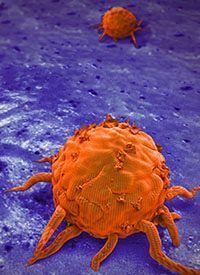Article
Surufatinib Shows Comparable HRQoL Vs Placebo in Advanced Neuroendocrine Tumors
Author(s):
Surufatinib demonstrated a comparable health-related quality of life with placebo in patients with advanced neuroendocrine tumors.
Surufatinib demonstrated a comparable health-related quality of life with placebo in patients with advanced neuroendocrine tumors.

Surufatinib demonstrated a comparable health-related quality of life (HRQoL) with placebo in patients with advanced neuroendocrine tumors (NETs), according to pooled findings from the phase 3 SANET-p and SANET-ep studies presented at the 2021 NANETS Virtual Symposium.1
Specifically, results showed that surufatinib was found to significantly decrease the risk of deterioration in dyspnea vs placebo (HR, 0.0058; 95% CI, 0.39-0.86). However, the agent also significantly increased the risk of deterioration in diarrhea (HR, 2.91; 95% CI, 1.66-5.10; P = .0001) vs placebo via the QLQ-C30 scales. There were no significant differences observed in time until definite deterioration (TuDD) between the 2 arms in other scales, including global health status/QoL, physician functioning, cognitive functioning, fatigue, nausea and vomiting, pain, constipation, and insomnia, among others.
Surufatinib is a novel, angio-immuno kinase inhibitor designed to simultaneously target both VEGFR 1/2/3, FGFR, and CSF-1R. In the phase 3 SANET-p (NCT02589821) and SANET-ep (NCT02588170) trials, surufatinib was found to significantly improved progression-free survival (PFS) vs placebo in patients with advanced pancreatic NETs and extra-pancreatic NETs, respectively.2,3
In SANET-p, the median follow-up in the investigative and control arms was 19.3 months (95% CI, 9.3-19.4) and 11.1 months (95% CI, 5.7-35.9), respectively. The median PFS per investigator assessment was 10.9 months (95% CI, 7.5-13.8) with surufatinib vs 3.7 months (95% CI, 2.8-5.6) with placebo (HR, 0.49; 95% CI, 0.32-0.76; P = .0011).
In SANET-ep, the median follow-up in the investigative and control arms was 13.8 months (95% CI, 11.1-16.7) and 16.6 months (95% CI, 9.2–not calculable), respectively. The investigator-assessed median PFS was 9.2 months (95% CI, 7.4-11.1) vs 3.8 months (95% CI, 3.7-5.7) with placebo (HR, 0.33; 95% CI, 0.22-0.50; P <.0001).
In July 2021, the FDA accepted the filing of a new drug application for surufatinib as a potential therapeutic option for patients with pancreatic and extra-pancreatic NETs, based on the SANET-p and SANET-ep findings.4
For the pooled analysis of the phase 3 studies, investigators sought to examine the HRQoL of surufatinib in this patient population.
In the pooled analysis, investigators evaluated patients with advanced, well-differentiated (grade 1/2) pancreatic NETs or extra-pancreatic NETs with disease progression in the past year, and progression on up to 2 prior systemic anticancer therapies. Patients, who must have had an ECOG performance status of 0 or 1, were randomized 2:1 to receive 300 mg of surufatinib daily (n = 242) or placebo (n = 128) until disease progression. At this point, patients on surufatinib were followed for survival and those on placebo went onto open-label surufatinib.
The primary end point was investigator-assessed PFS; secondary end points were objective response rate, disease control rate, duration of response, time to response, overall survival, and safety and tolerability. Quality of life was an exploratory end point.
Patient-reported HRQoL was measured at various timepoints: baseline, day 15 of cycle 1, day 1 of each subsequent cycle, and at the time of treatment discontinuation using the European Organization of Research and Treatment of Cancer QLQ-C30 and QLQ-G.I.NET-21.
The TuDD was defined as the time from randomization to the first deterioration of at least 10 points in domain score vs baseline score or death due to any cause. TuDD was tested with Kaplan-Meier estimators and unstratified Cox models, and P values were derived from unstratified log rank test.
The completion rate was determined as the proportion of patients among the intent-to-treat population who completed at least 1 scale of QLQ-C30 at each visit; the compliance rate was the proportion of patents who completed at least one scale of QLQ-C30 at each visit among those who were expected to complete the instruments at each visit. The change of scores from baseline were evaluated with the use of longitudinal method.
Investigators noted that the compliance rate of QLQ-C30/GI.NET21 was greater than 90% in both groups at all time points.
When TuDD was evaluated on the EORTC QLQ-C30 scales, surufatinib improved the reduction of the risk of deterioration in treatment-related symptoms (HR, 0.77; 95% CI, 0.31-1.93) and information/communication function (HR, 0.73; 95% CI, 0.45-1.19). Placebo performed slightly better in gastrointestinal symptoms (HR, 1.02; 95% CI, 0.68-1.54) and sexual function (HR, 1.12; 95% CI, 0.64-1.96).
Furthermore, least-squares mean differences from baseline to week 40 highlighted a trend toward benefit with surufatinib vs placebo at most visits except for diarrhea on the QLQ-C30 scale (increase of 14.9 vs 1.1 points; P <.0001) and muscle/bone pain symptoms on the QLQ-GI.NET21 scale (increase of 9.3 vs 3.9 points; P = .0303).
References
- Bai C, Xu J, Shen L, et al. Health-related quality-of-life analysis of surufatinib versus placbo for advanced neuroendocrine tumors: poled results from two phase 3 studies (SANET-p and SANET-ep). Presented at: 2021 NANETS Virtual Symposium; November 3-6, 2021; virtual. Abstract 150.
- Xu J, Shen L, Bai C, et al. Surufatinib in advanced pancreatic neuroendocrine tumours (SANET-p): a randomised, double-blind, placebo-controlled, phase 3 study. Lancet Oncol. 2020;21(11):1489-1499. doi:10.1016/S1470-2045(20)30493-9
- Xu J, Shen L, Zhou Z, et al. Surufatinib in advanced extrapancreatic neuroendocrine tumours (SANET-ep): a randomised, double-blind, placebo-controlled, phase 3 study. Lancet Oncol. 2020;21(11):1500-1512. doi:10.1016/S1470-2045(20)30496-4
- US FDA accepts filing of HUTCHMED’s NDA for surufatinib for the treatment of advanced neuroendocrine tumors. News release. July 1, 2021. Accessed July 1, 2021. https://bit.ly/3ycuQdd







